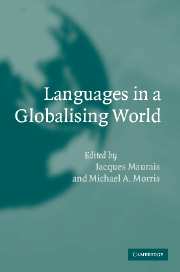Book contents
- Frontmatter
- Contents
- List of figures
- List of tables
- Notes on contributors
- Acknowledgements
- 1 Introduction
- Part I Global communication challenges
- 2 Towards a new global linguistic order?
- 3 The geostrategies of interlingualism
- 4 Language policy and linguistic theory
- 5 Babel and the market: Geostrategies for minority languages
- 6 Forecasting the fate of languages
- Part II Major areas
- Part III Languages of wider communication
- Conclusion
- Index
3 - The geostrategies of interlingualism
Published online by Cambridge University Press: 18 November 2009
- Frontmatter
- Contents
- List of figures
- List of tables
- Notes on contributors
- Acknowledgements
- 1 Introduction
- Part I Global communication challenges
- 2 Towards a new global linguistic order?
- 3 The geostrategies of interlingualism
- 4 Language policy and linguistic theory
- 5 Babel and the market: Geostrategies for minority languages
- 6 Forecasting the fate of languages
- Part II Major areas
- Part III Languages of wider communication
- Conclusion
- Index
Summary
Since the end of the fifteenth century, when the printing press delivered the means of linguistic standardisation into the hands of centrist rulers (Illich 1981; 1983), the field of language policy and planning has been dominated by what I call the politicostrategies of languages. Developing in tandem with theories of the nation and the state (Anderson 1983), linguistic politicostrategies have generally aimed to entrench the use of a single language in public administration and education, either across an entire state territory or within well-defined internal borders. As the processes of modernity have expanded through the twentieth century, ushering in a period of turbulent global change, the politicostrategists of language have continued both to defend the old national linguistic monopolies and to seek to establish new ones through corpus, status and acquisition planning (Cooper 1989).
In reality, however, such ‘politostratégies des langues’ are no longer adequate instruments of national or community policy. As late as the early decades of the twentieth century, it was possible for new national languages to play catch-up with the flagbearers – English, French and German – as measured in terms of their integration within a modern industrial economy and all of the standardised textual communication practices that accompany it (Smith 1990). Since then, however, a number of changes have taken place. National economies have become far more integrated in the global economy; money and workers have become much more mobile; the pace of technological change has accelerated to an unbelievable extent; and the explosive growth of communication and information networks is on the verge of ‘annihilating space’, as one current catch phrase has it.
- Type
- Chapter
- Information
- Languages in a Globalising World , pp. 37 - 46Publisher: Cambridge University PressPrint publication year: 2003
- 15
- Cited by

